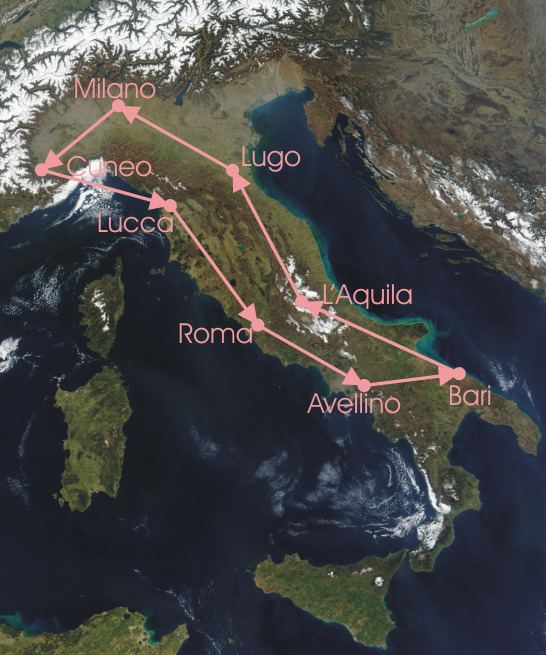Dates 24 May – 7 June Distance 3,162 km (1,965 mi) Second Pierino Albini (ITA) | Stages 8 Winning time 135h 17' 56" | |
 | ||
Winner Alfonso Calzolari (ITA) | ||
The 1914 Giro d'Italia was the 6th Giro d'Italia cycling race; it was organised and sponsored by the newspaper La Gazzetta dello Sport. The race began on 24 May in Milan with a stage that stretched 420 km (261 mi) to Cuneo, finishing back in Milan on 6 June after a 420.3 km (261 mi) stage and a total distance covered of 3,162 km (1,965 mi). The race was won by the Italian rider Alfonso Calzolari of the Stucchi team. Second and third respectively were the Italian riders Pierino Albini and Luigi Lucotti.
Contents
It was the last Giro before the Great War and the first one with a final classification based on time rather than points.
It is remembered as the hardest Giro of the heroic period of bicycle racing. Besides five stages of over 400 km (and the longest ever average stage length), it included the longest stage ever in the history of the Giro: the Lucca-Rome stage won by Costante Girardengo. This edition of the Giro was run at the lowest average speed (23.374 km/h); marked the highest gap between the first and the second (1 hour, 55 minutes and 26 seconds); saw the longest ever stage by time taken (the Bari-L'Aquila). Only 8 riders (of 81 participants) finished the race.
The sixth stage (Bari-L'Aquila) is remembered as the hardest stage in the history of the Giro, with a lot of riders forced to retire, including the first of the general classification Giuseppe Azzini, who was found the next day resting in a country house.
The Giro organisation declared Calzolari winner after the race, but a legal battle started between the Giro organisation and the Italian Cycling Union, who thought Calzolari should have been removed from the race for taking help from a car, making Albini the winner. After 14 months in court, the final decision was in favor of the Giro organisation, thus making Calzolari the definitive winner.
Participants
Before the race started, 98 cyclists had entered themselves in the race, of which 35 were professional cyclists in a team, 41 were professional cyclists without a team, and 22 were amateurs (Italian: aspiranti). Favourites for the race were Lucien Petit-Breton from France, and Ganna, Galetti, Girardengo, Giuseppe Santhià and Azzini from Italy.
At 24 May, when the Giro began, 81 of them started the race; only eight of them made it to the finish in Milan on 7 June. Riders were allowed to ride on their own or as a member of a team. There were eight teams that competed in the race: Alcyon, Atala, Bianchi, Ganna, Gerbi, Globo, Maino, and Stucchi.
The field featured three former Giro d'Italia champions in the 1909 winner Luigi Ganna, three-time winner Carlo Galetti, Eberardo Pavesi who was a member of the 1912 Atala winning team, and returning champion Carlo Oriani. Other notable Italian riders that started the race included Costante Girardengo, Angelo Gremo, Alfonso Calzolari, and Giovanni Gerbi.
General classification
There were eight cyclists who had completed all eight stages. For these cyclists, the times they had needed in each stage was added up for the general classification. The cyclist with the least accumulated time was the winner.
Of the two cyclists without a team, Sala rode as a professional Italian: isolato and Ripamonti as an amateur Italian: aspirante.
Aftermath
During the race, Calzolari, Canepari and Durando had been given a penalty of 3 hours, for taking help from a car. After the race, the Italian Cycling Union said that the Giro jury had made a wrong decision, and that the three cyclists should have been removed from the race, declaring Albini the winner. The Giro organisation did not agree, and declared that Calzolari stayed the winner. The two parties went to court, and in February the Giro organisation won, and again after an appeal in July 1915, making Calzolari the definitive winner.
Popular culture
As a result of the race's fearsome reputation, in the autumn of 2012, the British author Tim Moore rode the 1914 course on a period bicycle and wearing a recreated period costume. His exploits are detailed in his 2014 book, Gironimo! Riding the Very Terrible 1914 Tour of Italy.
